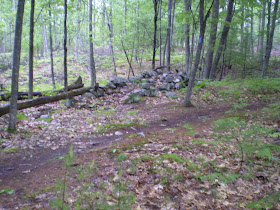 I don’t remember who I told about Libby Hill last winter. I suspected that there’d be something along the way from Little Sebago to the Royal River. This was the most likely rout from the Sebago Lake Region to the coast. The top of the hill once had a farm that belonged to the family that gave the hill its name. Beyond the old farmstead’s walls and cellar holes just west of the hill’s summit is a boulder with an odd peak that caught my eye. Next to it is a stone wall that I believe to be part of the old farm, but I’m noting it none the less. Further down the hillside from these were what looked to be boulders with rock piles on them and cairns; it was hard to say with the snow covering them.
I don’t remember who I told about Libby Hill last winter. I suspected that there’d be something along the way from Little Sebago to the Royal River. This was the most likely rout from the Sebago Lake Region to the coast. The top of the hill once had a farm that belonged to the family that gave the hill its name. Beyond the old farmstead’s walls and cellar holes just west of the hill’s summit is a boulder with an odd peak that caught my eye. Next to it is a stone wall that I believe to be part of the old farm, but I’m noting it none the less. Further down the hillside from these were what looked to be boulders with rock piles on them and cairns; it was hard to say with the snow covering them.I went back in May to find out that they were indeed cairns and rock covered boulders and not too far from those were areas with many rock piles. In the same area is a wall of sorts that looks more like an elongated rock dump. Further tromping on the hill led to the discovery of more rock piles and what may be a cairn or perhaps a short segment of stone wall that was started and abandoned. I wish I could tell you one hundred percent that this was not any part of any past farming activity, but the farmstead wasn’t more than a shout away from most of these sites. There is one small site that I’ll post later that I doubt was made by White farmers.
This entire site is owned by the town of Gray which maintains trails throughout. The town in order to gain revenue has had this land logged over many times. Both the trail building and logging has taken its toll on some of the piles. With this in mind I also remind you that this was farmland as well. The Libby family also operated some small granite quarries on this hill. At the risk or sounding like a broken record – the farm was abandoned around the time of the Civil War and had returned to being woodland by the 1890’s.




 [Rob continues] As I said, I had visited this site many times to get better photos. Each time I searched new areas. On the Lynx Trail I came across some small piles which scattered into the woods. I’m sure I hadn’t seen them all; most were easily hidden by the ferns and bushes. Further along the trail is a structure which I can’t decide if it’s a cairn or a short wall that was started but soon discontinued. I submit it for your speculation.
[Rob continues] As I said, I had visited this site many times to get better photos. Each time I searched new areas. On the Lynx Trail I came across some small piles which scattered into the woods. I’m sure I hadn’t seen them all; most were easily hidden by the ferns and bushes. Further along the trail is a structure which I can’t decide if it’s a cairn or a short wall that was started but soon discontinued. I submit it for your speculation.



 [...to be continued]
[...to be continued]
A couple of things:
ReplyDelete1. Abandoned in the 1800s, there were still plenty of Indians around after that who might remember and continue a ceremonial practice.
2. Unless we have the birth records from Europe for the Libby family we cannot assume they are European.
Modernity does not exlude woodland ceremonialism.